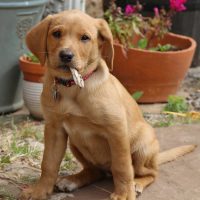 Q: How do I stop my puppy stealing items and chewing things they shouldn’t?
Q: How do I stop my puppy stealing items and chewing things they shouldn’t?
A: Fill your home with appropriate items for your puppy to pick up, chew on and play with that are far more satisfying than anything that doesn’t belong to them (and if it would be self-reinforcing to the puppy, keep it well out of access). Give the puppy loads of attention (and even drop some food in front of them) when they choose to pick up one of their own items. Ensure you introduce novel items regularly to prevent boredom. I have a mixture of toys, items from the recycling box, long-lasting chews and dried animal parts (this is not the time to be house proud!). If they pick up something that’s not theirs, just swap it for something that is if you’re that bothered – don’t make a song and dance of it, otherwise you create more value in the stolen item.
Q: What do I do when my puppy is doing a shark impression and snapping and grabbing at us?
A: Grab the nearest item (remember your house is now littered with them) and redirect them onto this. This behaviour is likely to be due to over-tiredness or play behaviour – so either help them wind-down and settle, or teach appropriate play with a toy.
Q: How do I get my puppy to move when they won’t? – when I grab their collar they bite me!
A: Get a solid recall and use this – motivate them to want to move, no need to get physical with them. In the meantime you may want to use a puppy houseline.
Avoid getting cross with your puppy – they don’t need to learn what is ‘wrong’, just what feels good to make them want to repeat the right stuff again. Your relationship is more important than nagging or “ahah” or “No!” and just increases confusion and frustration in the pup. Think of what you DO want your puppy to do and set them up to practice these behaviours, or redirect them if necessary.
“Discipline: the practice of training obedience, rules or a code of behaviour using punishment to correct disobedience.”
There are numerous issues associated with teaching animals in this way. Potential fallout includes:
1) Damaging your relationship.
2) Increasing potential for defensive behaviour from the animal.
3) Not teaching them what we DO want them to do, leading to stress, confusion, learned helplessness, frustration…
4) Escalating or inducing feelings of frustration, fear and anxiety (and simply suppressing the unwanted behaviour).
5) Temporarily interrupting behaviour, requiring escalation of punishment over time because the motivation to perform the unwanted behaviour outweighs the motivation to avoid the punishment.
6) Avoidance behaviour.
And much more.
So, to prevent these risks I teach my puppy what I want her to do instead.
I set up the environment so that she is unable to rehearse any unwanted behaviour. I provide her with loads of opportunities to rehearse desired behaviours which are either self-reinforcing or which I can heavily reinforce. Reinforcement, by definition, means these behaviours will increase in frequency.
If she does exhibit unwanted behaviour, I might ignore it (if it is not self-reinforcing, dangerous to her or to others); otherwise I will redirect her onto a more appropriate activity which can be reinforced. I have had no need to finger-point or get cross, even if she has managed to do something I didn’t want her to do. Key things to train to be able to do this include a reliable recall, a reliable ‘drop’ cue, and the ability to stay positioned somewhere around distractions.
If you can’t think of a way to alter unwanted behaviour without using verbal or physical positive punishment, seek advice from a force-free trainer.